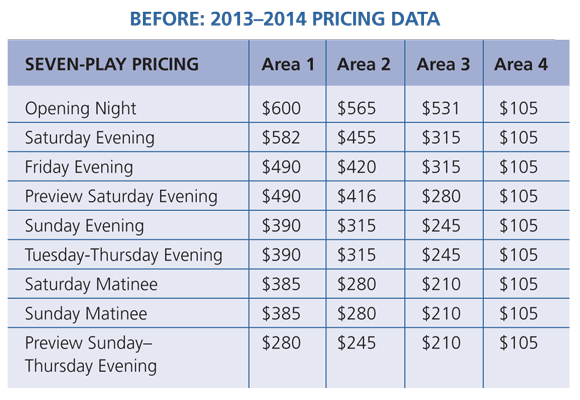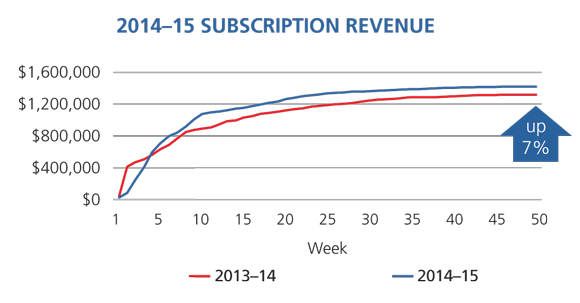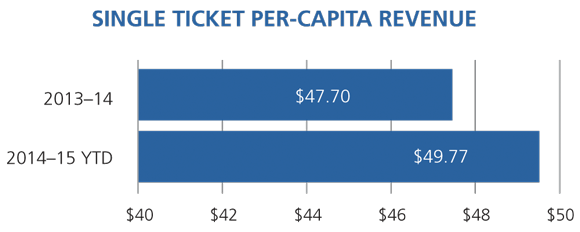19% increase in average subscription revenue
The Situation:

|
The cast of DTC’s production of
Rocky Horror Picture Show.
Photo by Karen Almond.
|
Dallas Theater Center (DTC) hired TRG for capacity building consulting in November of 2013. DTC faced challenges with pricing, in particular reinforcing loyalty through pricing. Founded in 1959, DTC became a resident company of the new state-of-the-art AT&T Performing Arts Center in 2009. The new venue’s flexible mainstage, the Potter Rose Performing Studio at the Dee and Charles Wyly Theatre, enables DTC to configure seating differently for each production, from 1 to 573 seats. DTC also produces in a traditional 99 seat “black box” space at the Wyly and at its original home, the 491 seat Kalita Humphreys Theater, the only freestanding theater designed and built by Frank Lloyd Wright.
Time Lapse Transformation - Dee and Charles Wyly Theatre
This video shows a time lapse of the reconfiguration of Dee and Charles Wyly Theatre, one of the most versatile theatrical performing spaces in the world.
Challenges presented by changing scale plans
While the seating in the new venue allows for a tailored experience for each production, it makes pricing more complex than at most theaters, as seating configurations change for almost every production. When TRG began working with DTC, the last 19 productions at DTC used 13 different seat maps.
Though each map in the Wyly and Kalita theaters had four price zones, DTC didn’t keep the percentage of seats within those four zones consistent from map to map. The different maps created abundant work for DTC staff, both in the ticketing system and in reconciling revenue projections. From the patrons’ perspective, the fact that seating was rarely the same became a barrier to sales and a barrier in building consistent and loyal audiences. For example, DTC could not publicize theater maps on the website or in their collateral, because there were simply too many. Patrons were unable to see the seats they were purchasing on a seat map, or even the location of the price zones within the theater.

DTC listed nine different price tables for subscriptions on different days and times.
Different price plans
DTC offered many different subscription packages from which patrons could choose. Once patrons selected how many plays they wanted to see, there were different price points for different areas of the house, and nine price options within those areas for different days and times. While this model offered a variety of choices, patrons are less likely to buy when the purchasing process is too complex. Single ticket pricing tables were structured similarly, but the variations between single and subscription prices were inconsistent. This sometimes meant that single ticket buyers paid less than subscribers, negating the loyalty principle that subscribers should be rewarded by receiving the best prices.
Changes compete with the ability to create habits
One key to building patron loyalty is the ability to make your art form a meaningful part of people’s lives. It’s about building cultural habits with and for your institution. A pathway to habit-building is consistency.
At DTC, single ticket buyers had to navigate a new theater orientation for every purchase. Subscribers had different seats for nearly every production. Though artistically exciting, this prohibited a culture of consistency. Sitting in the same seats builds habits and traditions, which in turn builds loyalty.
All these factors together made the ticket-buying process a confusing experience, without a clear value proposition.
The Results
With a new scale plan, a commitment to consistency, and improvements to the subscription campaign plan, DTC saw the following results in just one year:
- a 19% increase in average subscription revenue per package
- a per capita revenue increase of 21% for new subscribers
- a 7% increase in overall subscription revenue

DTC also achieved a 3% increase in per capita single ticket income.

How they did it
When DTC and TRG sat down to re-work the pricing strategy, they agreed on a few goals:
- Streamline the scale plan and price tables to reduce the internal work load created by these scale plans
- Enhance the perception of success while increasing revenues
- Use pricing to reward loyalty
“An advantage of working with TRG for this process is that they utilized the data which our DTC team had diligently stewarded and industry best practices to devise a tailored plan,” Managing Director Heather Kitchen said. “Both our staff and board leadership could get behind the plan because it integrated pricing, loyalty, and data best practice. I was glad that we’d made past investments in strengthening and stewarding our patron data. Once TRG became a partner, we were ready to act.”
Simplifying scale plan
The first thing TRG did was work with DTC to normalize the percentage of tickets at every price point available. For example, in any configuration or theater (except in the 99 seat “black box” configurations), DTC now has 66% of the seats at the top price point, 22% and 13% at the middle price points, and 10% at the lowest price point. The amount of inventory by price point was determined by DTC’s historic sales demand. When the percentage of tickets at each price point is consistent from scale to scale, pricing of subscriptions and single tickets can be consistent. Instead of guessing the percentage of each price point that would sell, DTC let historic marketplace data tell them what would be in demand. DTC now cultivates a consistent number of audience members, from a price point perspective, no matter what size venue they use.
Collapsing price tables and packages from 9 to 3

|
Chris Hury and Sally Nystuen Vahle in DTC’s Medea.
Photo by Karen Almond.
|
DTC had created nine different price tables based on demand for day of the week and time of day. If they thought there was demand, they would charge more; however, the price points weren’t balanced consistently. Price jumps needed to be adjusted so that that the difference in price tables could be justifiable to the patron. TRG looked at what these strategies had yielded and came up with three questions to guide simplification:
- Are previews perceived to be of lesser value artistically?
- Are Friday and Saturday more consistently in demand and yielding more revenue?
- Can we put everything else in one bucket without losing substantial revenue?
DTC answered yes to each inquiry and a new price plan was born, based on the day of the week and whether or not the performance was a preview. Once the number of price tables DTC needed was determined, price jumps between the price tables in “mental math”-friendly increments were established. Now DTC’s patrons can intuitively follow the price tables.
Enhance the perception of success
TRG introduced a hold-and-release plan for tickets. DTC would hold some sections from sale to allow the theater to fill from front to back and side to side. The plan now affirms loyal behavior and ensures that, no matter how much capacity is sold, the audience will have a communal experience. In addition to holding and releasing sections of seats, DTC re-zoned their scale plan, moving the least expensive seats to the traditionally-empty yet highly visible section of the house.
“The flexible seating in our new venue was exciting for artists and patrons alike,” Kitchen said. “Adding consistency to scale plans ensured a more intimate artistic experience for the cast and it provided a deeper sense of community for our patrons.”
Using pricing to reward loyalty
DTC further strengthened the value proposition of subscribing by rewarding subscribers with the best prices. Based on the single ticket prices for day and time and type of show, DTC worked backward to the subscription price. Pricing was built to reward loyalty. Simply put, the more someone purchased/committed to the organization, the greater discount they received. Thus, full series subscribers saved more than Design-Your-Own subscribers. Yet they all saved over single tickets as a way of rewarding loyalty.
Actionable Changes
DTC’s simplified and loyalty-based scale and pricing resulted in a stronger sales message for new and renewing subscribers. As such, the organization had another way to communicate and illustrate how they valued their most important patron base. The simplifying of price tables also valued the artistic product in a way that was consistent with patron demand, not the organization’s assumptions. Subscribers renewed in ways that validated the new pricing. And per capita revenues increased!
“We’re thrilled by the increases and results we’ve seen since we started thinking about loyalty and pricing as an integrated approach. This case study reflects our first year of results. Yet, early indicators for the 2015-16 season are pointing to even stronger growth,” Kitchen said. “We are only 15 weeks into the new campaign and we have already matched last season’s renewal percentage, and both revenue and number of units are almost 12% ahead of our expectations.”

|
The cast of DTC’s production of Colossal.. Photo by Karen Almond.
|
About Dallas Theater Center
One of the leading regional theaters in the country, Dallas Theater Center (DTC) performs to an audience of more than 120,000 residents annually. Founded in 1959, DTC is a resident company at AT&T Performing Arts Center and produces its season there at the Dee and Charles Wyly Theatre as well as at its original home, the Kalita Humphreys Theater, the only freestanding theater designed and built by Frank Lloyd Wright. DTC engages, entertains and inspires a diverse community by creating experiences that stimulate new ways of thinking and living by consistently producing plays, educational programs and community initiatives that are of the highest quality and reach the broadest possible constituency.
Glossary
| Demand |
In the context of arts pricing, the value that patrons place on an artistic experience, expressed through purchasing behavior. It’s what should drive ticket prices up and down. |
| Hold-and-release plan |
A customized plan based on historic sales patterns, where sections of seats are held back from sale and released into inventory as sales increase. The plan is designed ensure a perception of success in all capacity-sold situations by filling the venue from front to back and side to side. |
| Price jump |
Difference between price points |
| Price point |
The price of a ticket |
| Price table |
Ticket prices for each performance. Within a production, prices can vary by day of the week, time of day, type of event, and other criteria. |
| Price zone |
Areas of the house that have the same price point |
| Scale of house |
Determines the price points for each seat in the hall. Also called scale of hall or scale plan. |
| Seat map |
A diagram of the venue that shows which prices are assigned to which seats |
| Seating configuration |
How seats are arranged in the hall. For most venues, this does not change unless seats can be removed or added. |
Download this case study
To download a PDF of this case study, complete the form below: